Where to go in Switzerland on a short trip: Alps, lakes, and cities
Switzerland is an extremely popular country for those planning multi-stop tours around Europe, yet very few potential first-time visitors actually know specifically where they want to go. Everyone seems to know that it has the most beautiful views of the Alps and some very impressive cities, but there are actually many misconceptions among casual trip planners, so I’d like to clear most of that up below. The places to visit in Switzerland are not obvious until you’ve been there yourself or done many hours of research, so the list below should be a short cut.
I get hundreds if not thousands of itinerary questions for people who are considering a Eurail trip around Europe, and most people just include the word “Switzerland” among a list of cities like Paris, Rome, and Berlin that they want to visit. So where in Switzerland should you go if you can only make a few stops at most? I’ll answer that question below. You’ll mostly want to focus on the best choices for Swiss Alps trips, which I’ll go over below.
Note: This article was expanded and updated in February, 2024.
Switzerland is about outdoor views rather than city visits
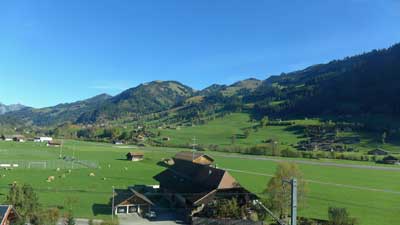
Geneva is a very famous city (though not for tourism reasons) on a lovely lake of the same name, but it’s also notoriously dull and lacking distinction. Rick Steves puts it well by saying that “Geneva is pleasantly situated on a lake, like Buffalo or Cleveland.” The point is, you don’t want to go to Geneva unless you’ve got something specific in mind that you want to see there. There are much better places to visit in Switzerland if your time is limited, or even if it’s not.
Switzerland's cities in summary
Zurich – The largest city, very expensive, geared towards business travelers. It’s generally a pretty and very well-run city that you would enjoy if you visited, but it’s not nearly as interesting as the likes of Vienna, Munich, or of course Paris.
Geneva – Second largest city, in the French part of the country, no major sights. Again, if you visited you’d be very impressed by it and get some great photos, but it’s not worth your time unless you know someone there. There’s an impressive fountain in the lake and you can usually see it from the train as you go through the city, but it’s not really worth going there and staying more than an hour or so.
Basel – Bordering France and Germany, no major sights. It has the famous art market each year, and aside from that it’s even duller than the ones above. Again, if you visited you’d be impressed, but if you later compared photos with friends who went to the Lauterbrunnen Valley instead, you’d kick yourself for going to Basel.
Lausanne – Near Geneva in the French part of the country, very hilly, and certainly more interesting than Geneva.
Bern – The capital, compact, on a lovely river, some interesting sights and the best Swiss city to get a feel for the culture. Bern is fairly close to Interlaken (which we will discuss below) and it can be a great day trip from there, especially on a day where it is foggy and/or rainy in the mountains (and this happens a LOT).
How much time and which Swiss cities to visit?
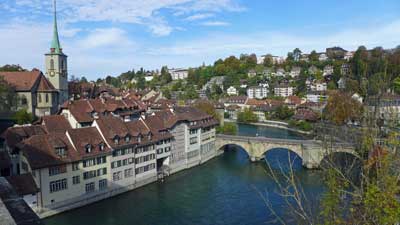
Many people (me included) don’t feel as if they’ve scratched the surface of a new country if they haven’t spent at least a day or two in the largest city. Zurich is certainly pleasant and a useful transit hub so spending one or two nights there wouldn’t be a major mistake. But Zurich isn’t even close to being a city like Paris, Rome, Berlin, Amsterdam, or even Vienna. If you skip it in favor of spending more time in the Swiss Alps, you won’t be missing much.
The 2 Best places to visit in Switzerland for short visits
Interlaken – If you want the best possible Alpine views and activities, head to the Interlaken area, which will be described in detail below. This is my favorite of all places to visit in Switzerland and it will probably be yours as well.
Lucerne – The traditional Swiss tourist retreat, Lucerne is a small city with interesting culture and sights, that is gorgeously set on a lake with plenty of top activities surrounding it.
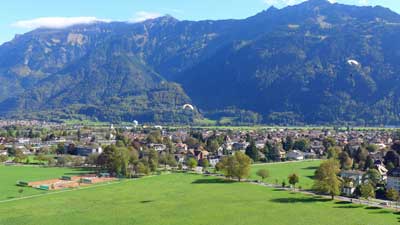
>>>Interlaken and Lucerne: Which to choose and how long to stay in each?
The article linked above will give you more details on which to choose and how long to spend in each place.
What about Zermatt for Alpine views?
Zermatt is a remote car-free village in southern Switzerland that is famous for being the place to see the Matterhorn mountain. It’s also a busy ski resort area, and aside from that, there isn’t much to see or do here. It’s on a private rail line, so it’s more complicated and usually more expensive to reach than Interlaken.
In other words, unless you’ve irrationally placed “Seeing the Matterhorn in person” on your so-called bucket list, skip Zermatt and head to Interlaken on a shorter visit. You won’t be sorry. If you already have enough time in your visit for the main sights around Interlaken and Lucerne and you want to also see the Matterhorn, then by all means go and you’ll enjoy it. There are quite a few other car-free villages in the Lauterbrunnen Valley near Interlaken, so they are not as novel in Switzerland as one might expect.
A weekend in Switzerland? What to see in 3 days
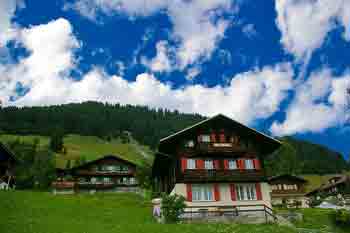
One challenge is that neither has an international airport so you’ll either be flying into Zurich or perhaps Geneva.
Train times from Zurich to Lucerne to Interlaken and back
- Zurich Airport to Lucerne: 1 hour 10 minutes by train
- Lucerne to Interlaken: 2 hours by train
- Interlaken to Zurich Airport: 2 hours 15 minutes by train
As you can see with the travel times above, Zurich Airport to Lucerne is a fairly short trip, but once you add Interlaken into the mix (even if you skip Lucerne) the travel time starts to add up for a weekend visit. With this in mind it’s probably best to just choose one of them and save the other one for another trip.
Lucerne is gorgeous, but the Lauterbrunnen Valley near Interlaken is really the star of the show, so I’d recommend going there first and doing Lucerne on another trip.
What about the Swiss Travel Pass?

The bottom line is that if you are coming to Switzerland for at least 3 days and you want to take 2 or more of the amazing scenic rail journeys that the country is famous for, the travel pass is probably a good deal. It also provides 50% discounts on the Schilthorn cable car and 25% off the Jungfraujoch mountain railway. Both of those are quite expensive on their own, but extremely worthwhile, so the discount is helpful.
The Half Fare Card is probably a better deal for most people
The Swiss Travel Pass is a good deal for those who are going to be spending at least 2 or 3 days riding the rails and seeing Switzerland that way. But if you are mostly going to be focusing on Interlaken and Lucerne and the mountain sights, the Half Fare Card is the best option. For CHF120 (about US$134) you get the card that is good for 30 days and gives you a 50% discount on all trains, cable cars, mountain railways, and other sights and attractions. If you are doing either Schilthorn or Jungfraujoch, the Half Fare Card practically pays for itself with just one of those.
>>>Buy the Swiss Half Fare Card
Many people have questions about the Swiss Half Fare Card so I will explain it a bit here. You can actually buy half price train tickets for travel within Switzerland any time you want and you will see that option when you go to buy them online. The only thing is you have to have and present a valid Half Fare Card when you get on the train and are asked to see your ticket. In other words, you can buy a half fare train ticket today and buy a Half Fare Card just before you get on that train months in the future, and you are fine.
How and why visit the area around Interlaken
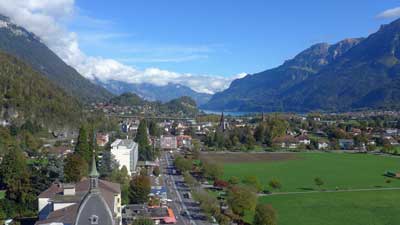
You can see everything discussed below by actually staying in a hotel in Interlaken, but it’s not the Alpine experience that you get if you stay in one of the small villages nearby. You can reach those villages in 20 to 40 minutes from the Interlaken Ost (East) train station, and it’s much easier than it sounds.
The 3 best places to stay to visit the Swiss Alps
Lauterbrunnen – A private train line runs from Interlaken Ost station to the end of its line in Lauterbrunnen. There’s a lovely waterfall here and great hiking trails, but you should probably only stay here if you can’t get to one of the villages mentioned just below. It’s a great little transit hub and it’s definitely gorgeous, so it can be worth a night if you’ve got one to spare.
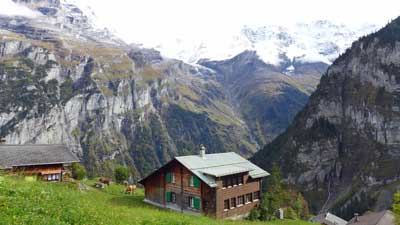
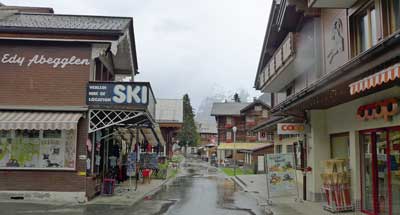
Where to stay in Interlaken and the Lauterbrunnen Valley (with pics)
I get so many questions about where to stay in the Interlaken area that I decided to write a longer version of it and load it with huge photos so readers can get a better feel for each option. I also included recommendations for affordable and well-located photos in each area.
>>>Where to stay in Interlaken and the Lauterbrunnen Valley New for 2024!
The unforgettable things to see here (if the weather is decent)
Schilthorn observation deck and restaurant
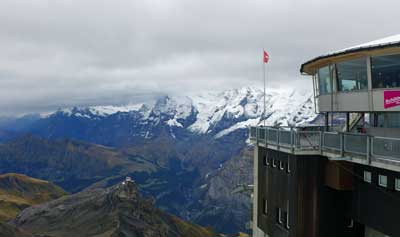
There is a rotating restaurant (with prices similar to normal Swiss restaurants) and a bizarre and anachronistic James Bond attraction based on it being a key location in the 1969 movie On Her Majesty’s Secret Service. The Bond thing is included with the lift, and it’s worth a look.
But the main thing you come here for is the 360-degree view from one of the highest peaks in Europe. Again, the weather here is key, but fortunately all the locals track the visibility on a minute-by-minute basis. If it’s clear up top while you are in the area, it would be a terrible shame to skip it based on the high price. But even if it’s cloudy up top, there are still plenty of wonderful things to see and do in the villages below.
Jungfraujoch observation area
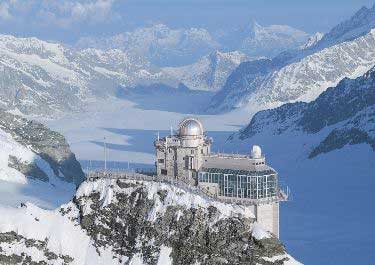
The views from the top are similar to the views from Schilthorn, from the other side of the Lauterbrunnen Valley. Once on top you can have lunch, hike, or even go sledding. It’s also quite expensive at nearly US$200 round-trip unless you have a Swiss Pass or a Eurail Pass for discounts, and it takes most of your day, but you’ll never forget the views from the top.
Harder Kulm mountain and Two Lakes Bridge Observation Deck
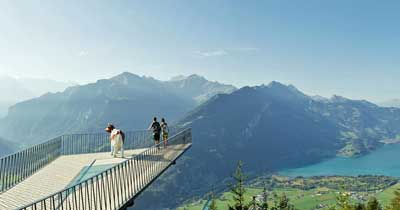
There’s a revolving restaurant about 10 minutes’ walk from the station at the top, which is definitely an unforgettable place for lunch if you’ve got time. It’s not as expensive as you might expect, at least compared to normal restaurants in Switzerland.
The Harder Kulm Railway goes from early April through late November each year. If you are only in Interlaken for one day and/or you are on a strict budget, this is the fastest and best way to get amazing Alpine views in the area.
Getting from Interlaken to Gimmelwald and Mürren
Getting up to these villages sounds complicated and time consuming, but it’s actually fast and easy once you get there. This little guide should help.
Arrive in Interlaken
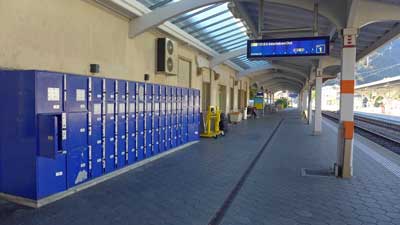
Once you arrive at the Interlaken Ost train station, head for the ticket windows in the office and buy a ticket to your final destination (Lauterbrunnen, Gimmelwald, or Mürren). Eurail passes are good for 25% discounts on the rest of the trip, but not for the whole thing.
From Interlaken Ost to Lauterbrunnen
The private train leaves Interlaken Ost every 30 minutes and arrives in Lauterbrunnen 20 minutes later. If you are staying in Lauterbrunnen then you are probably walking distance from your hotel when you reach the station.
From Lauterbrunnen to Gimmelwald
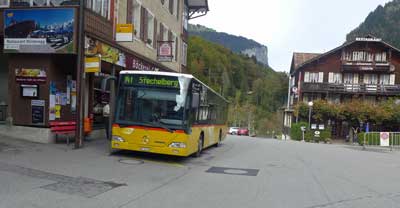

From
Gimmelwald to Mürren
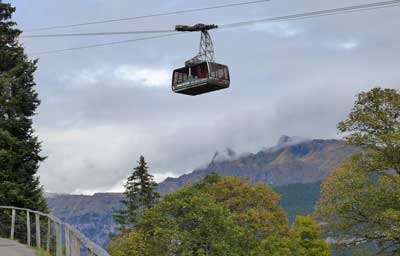
Recommended hotel and hostel in Gimmelwald
I get asked all the time about where to stay in Gimmelwald, so here it is:
Hotel: Esther’s Guesthouse
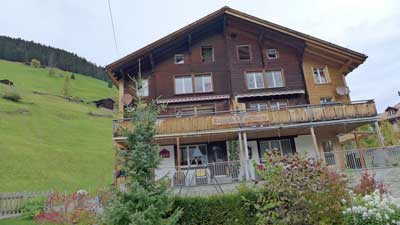
It’s run by Esther, as you might guess, and she is very friendly speaking excellent English. Each room is different and the place feels like a mountain cabin, because it is. She offers an excellent buffet breakfast in the morning, which you have to order the night before. It’s not cheap, but it’s worth it because it’s hearty and there are no other good options nearby.
Book as early as possible because this place is often the first place to sell out in Gimmelwald.
Hostel: Mountain Hostel Gimmelwald
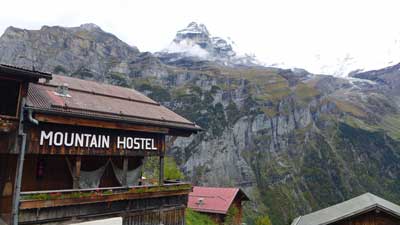
You won’t believe the views from this place, which are the same as from Esther’s except a bit lower and more unobstructed. This place also has a busy bar and restaurant that is basically the only “nightlife” in Gimmelwald. Many hikers get to bed early in this tiny village, but if you want to have a couple drinks and order a pizza or some local options, this is the place to go.
Again, book early because this place is always sold out.
Lucerne and what to do there
Luzern, as it’s spelled locally, is the other traditional holiday destination in Switzerland. Unlike Interlaken, Lucerne actually qualifies as a small city rather than a small resort town, so it’s a very nice contrast and very worthwhile. We have a new article with advice on where to stay in Lucerne and it should be helpful.
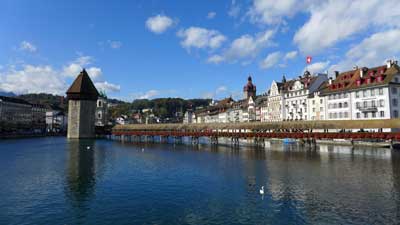
However, unlike Interlaken, the town of Lucerne itself is a great attraction and worth at least a day of exploration. This has always been a rich area so you can expect to find all of the high-end shops and boutiques along the small streets just north of the lake, but there are also many traditional shops and things to see that will appeal to anyone.
Recommended hotel in Lucerne
>>Hotel Des Alpes (3 stars with an amazing location and view)

If this place is booked, which is often the case, then book a hotel as close to it as you can find or afford. The whole historic part of town surrounding it is lovely, with restaurants, bars, and high-end shops. There are also a couple of nearby supermarkets where you can buy inexpensive alcohol and picnic supplies to keep other costs down.
Spend a day in Lucerne itself
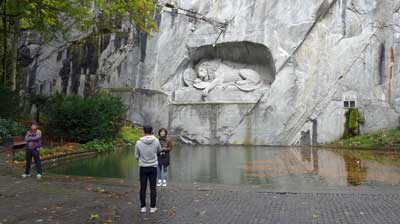
Most of the interesting part of Lucerne is in the area behind those restaurants, and it’s certainly worth doing a self-guided walking tour if not a guided one. Heading farther east you’ll come to another older part of town where the famous lion statue is located. You can’t visit Lucerne without having a look at the lion, and fortunately it’s easy and quick to reach (and it’s free).
Take a lake cruise of some kind
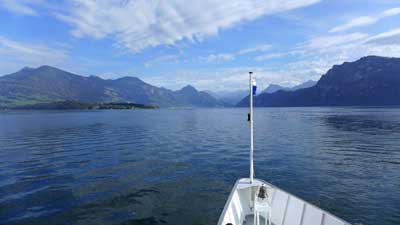
Especially in nice weather, even the short lake tour is lovely, and if you have more time you can jump off at Vitznau and do the scenic hike up Mount Rigi. There are also small lakeside villages that are ideal for a stroll and lunch stop. Long story short, there are dozens of interesting sightseeing options that are available using part of the boat tour, and the views all around are wonderful.
Visit Mount Pilatus
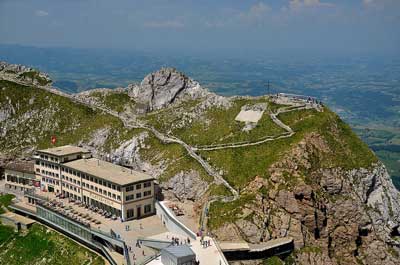
You can take the cogwheel train up and have a more or less flat hike around the summit area, and then take the gondola and cable car back down again. You can do them in the other order, and the cost is the same either way. At around US$65, this is not a cheap hike, but like most everything in Switzerland, the quality is high so it doesn’t feel like a rip-off. You can reach the cable car in 10 minutes on a public trolly bus from Lucerne.
Visit Mount Rigi
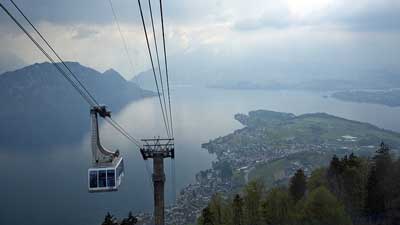
Unlike the other peaks mentioned in this article the Swiss Travel Pass covers both ways to get up and down for free. The others are 50% off with the Swiss Travel Pass or Half Fare Card, except for Jungfraujoch, which is only 25% off with the Swiss Travel Pass and still 50% off with the Half Fare Card.
Visit Mount Titlis
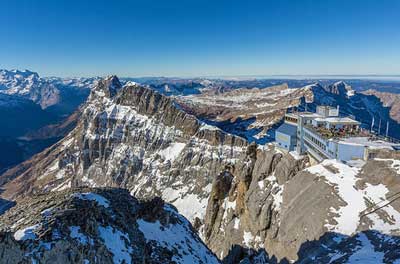
You can reach Titlis by taking a 43-minute train ride from Lucerne to Engelburg and then taking the cable car up from there. As with the others, it’s wise to check the weather immediately before you are going to depart because it can be foggy or cloudy any time of the year, but usually not for whole days at a time.
Additional photo credits
Jungfraujoch by cupweuro on Flickr, Pilatus by Tony Fernandez on Flickr, Rigi by Kosala Bandara on Flickr, Titlis by PaulSchliebs on Flickr

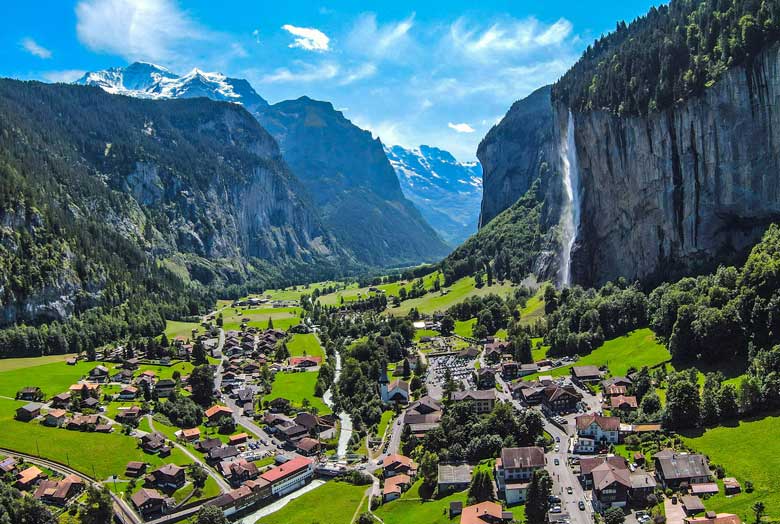
Hi Roger
Greetings
great job ,answering so many people
We r reaching Geneva on 1 Oct at 3:25 pm.We had already booked a resort in Haute Nendaz from ! to 5 Oct,as we thought it would be centre point for Zermatt and Interlaken.Now after reading your article,I thought we can avoid zermatt and just see interlaken ,Lucerne,wengen…..
Now help us with a perfect itinerary so that we can cover maximum places in less time. We will be leaving on 5 at 12:35 pm from Geneva.Suggest one scenic tour also
Regads
Neelam
Now
Neelam,
One of the best things about Switzerland is that every train journey is a scenic one. There are 10 or so “scenic trains” that the tourism board promotes, and all of them are wonderful, but most of them take a whole day round-trip. Since you only have 4 days my recommendation is to just go to the places that interest you and you’ll find that the train rides will all be great. You’ll be on a few of the scenic routes as well, but you’ll only be taking parts of them. Anything near the Alps is stunning. Have a great trip. -Roger
Hi Roger
We have booked our resort in Haute Nendaz (as this was the centre place for Zermatt and interlaken)from 1 to 5 of Oct.We r planning to reach Geneva as it is the nearest airport from our resort.After reading your article ,I need one suggestion.Will it be fine to travel everyday to interlaken,Murren etc and back to Nendaz.or staying in interlaken for a day would be more cheaper than commuting to and fro as well as saving time to visit places near interlaken?
Neelam,
I am not familiar with Nendaz, but I looked it up just now. It doesn’t seem to be on the rail lines, and it appears that a bus from there to Interlaken takes about two hours each way. From Interlaken to Gimmelwald or Murren takes at least an hour as well, so that would be a minimum of 6 hours travel time to do it as a day trip. If you can stay at least one or two nights in Interlaken, I think it would be well worth it. Have a great trip. -Roger
Hi Roger!
Thank you for the advise and tips above.
I’ll be going to Italy and Swiss (12 – 23 Sept 2016 tentatively, but may be extended till 25 Sept) and Would appreciate your comments/input for my planned itinerary.
Will be traveling on an “all girls trip” with my mum and aunt. (both in mid 50s and i’m in mid 20s)
12/09 – Arrived in Rome @2pm from Sin. (Rest to cope with Jetlag)
13/09 – Colosseum, Trevi Fountain, Spanish Steps, Roman Forum, Pantheon, Piazza Navona.
14/09 – Vatican City
15/09 – Rome to Florence
16/09 – Florence – Pisa – Cinque Terre – Florence
17/09 – Florence – Venice
18/09 – Murano & Burano
19/09 – Venice – Milan – Interlaken
20/09 – Interlaken
21/09 – Interlaken
22/09 – Lucerne
23/09 – Lucerne – Zurich – Sin
i know the itinerary seems a bit tight.
But i would like to cover as much as i can as its the ladies first time in Europe!
We are not into any museums kind, more for picture takings and more into scenic sights.
I saw many said Vatican City will take up a day, but is it possible to cover it in half day, so we can travel out of Rome earlier?
Do you think Florence should be considered to overnight at? I have heard about Florence being very charming and beautiful city, but when i look upon it on web, its more of art and museum which i believe it will not interest my 2 ladies. But then again, i thought Florence will be a good connection to Pisa and Cinque terre.
I’ve been to Venice, and it captivates me so much that i want to go again. But Venice seems out of the way to Swiss. Would you suggest to remove it or do a day trip from Florence?
I have been looking at the places i would like to go in Swiss, but i need your help on how to go about.
Firstly, where should our days in Swiss be based at? Interlaken? Preferably 1 base (or 2 the most) as we will be with 3 big luggage and moving around will be tedious.
These are the places i have in mind to go (but not restricted to):
First cliff walk by tissot, Bern, Mt titis, Schilthorn, Gimmelwald, Murren, lake cruise.
Appreciate if you could suggest the itinerary in Swiss and how to go about from places to places.
and, do you recommend us to get the Swiss Travel Pass?
I’m quite interested in doing the paragliding, and also would like my ladies to try it.
Do you think a paragliding trip could be planned in as well?
Sorry for the overload of questions! Its my first time planning for a trip and i’m really bad at it. and time are ticking so fast and i’ve nothing set at the moment.
Thank you so much Roger for your help!
Penny,
I’ll try to answer the questions in the order they came up…
As long as you get to the Vatican City early and hopefully have a reservation so you can skip the ticket queue, you can see the highlights of Vatican City in around 4 hours. It will take you a bit of time to get in, and once you are inside you follow a one-way route through the museum, which ends shortly after that Sistine Chapel. Even though you may not like museums, this museum is amazing and is not to be missed. You can move through it pretty quickly if you like, and maybe be out in 90 minutes. After that it’s just a matter of going next door to St. Peter’s Basilica. You’ll want to look around there for maybe 30 minutes, and then you’ve done all the highlights.
I’d definitely overnight in Florence. It is known for art and museums, but it’s also the capital of Tuscany so it’s an excellent stop for food and general culture. It’s also very visitor-friendly, which isn’t true of Pisa or Milan. If you go to Pisa from Florence it will take about 4 hours total if you want to spend about an hour near the Leaning Tower and cathedral. I really wouldn’t recommend Cinque Terre in the remaining half day, especially if it means skipping most of Florence. You’d really only have time to take the train through Cinque Terre, and maybe hop off in Vernazza for a walk around before you’d have to be on the train back to Florence. You can’t see much from the train, and Vernazza will be so crowded with other tourists that it feels like Disneyland.
I agree that Venice is amazing, and you can enjoy it on around a 24-hour stop there. If you can work it in, I think the others would love it.
I think your plan for 2 nights in Interlaken and 2 nights in Lucerne sounds very good. In both towns you can get a hotel within a fairly short walk of the train station, and then do your sightseeing after that. It’s actually very easy to get luggage up to Gimmelwald or Murren though, and I think it’s worth it to stay up there if you can.
I can’t really offer more of a specific itinerary than the suggestions I make in the article above. Really, every place and view in Switzerland is just breathtaking, so you really can’t go wrong. Also, if you do Schilthorn, you can get to the top in less than 2 hours from Interlaken, or 1 hour from Gimmelwald or Murren. After Schilthorn you can stop in Murren for a walk around and then walk downhill to Gimmelwald. The views are amazing and it’s so charming you can’t believe it exists. You can be back to Interlaken after all of this in 4 or 5 total hours, so that’s only half a day.
You hopefully noticed that I did a long review of the Swiss Travel Pass. I don’t think it would be good value for you, because it’s usually only worth it for those planning at least two of the more expensive scenic train rides.
There are several paragliding outfits in and around Interlaken, and you’ll see them for sure. I’ve not done it, but I assume it would be easy to book when you are there.
For Switzerland, just choose the things that pop out at you when you read about them or see the photos. It’s all incredible. Let me know if you have any other questions. -Roger
Hi Roger
Thanks for helpful words. can you please suggest me 2-3 day Swiss travel route if i travel from Germany to Swiss to Italy (Venice) and if i want to travel from Italy-Swiss-Provence-Paris. It should be include 1 day stay at city and 1 day travel by Panoramic train travel towards our further destination as mention above ether Italy or France (Provence).
Vikram,
I’ve only taken a few of the famous “scenic trains” around Switzerland so it’s hard for me to choose which ones you should take. However, what I can say is that virtually every kilometer of track in Switzerland is extremely scenic, and in my opinion those “scenic routes” are more of a promotional tool than anything. It’s true that some of them have special panorama carriages, and those are very nice if you reserve far enough in advance to get one of those seats. But in general, if you just go on the trains that you’ll need to get between the places in Switzerland that you want to visit, you’ll be amazed by the scenery.
And every train that goes along and through the Alps has stunning scenery. So my advice is to decide on which places in those areas you want to visit, and then book the trains between them. In some cases you’ll have panoramic carriage options, and if you can book those early enough it will be worthwhile. Have a great trip. -Roger
Hi Roger,
We look forward to a trip to Switzerland in third week of September and since it is our first trip we will mainly visit the scenic central region ie: Lucerne, Interlaken, Jungfrau, Engelberg and may be a day trip to Zermatt.
Need your help to chose a base location where we can stay for 4-5 days and offers the following:
1) Convenient travelling- ie: frequent trains and well connected to each of the above areas of interest
2) Good to options to spend evenings in leisure – markets, boat rides etc
3) vegetarian Indian food which is not obnoxiously priced. Can’t do without it 🙂
Kindly advise.
Thanks
Mehul
Mehul,
Your best options for a home base would be Lucerne or Interlaken, but I think you want to go to Interlaken. It’s more central for what you want to see, and hotels near the two train stations should be cheaper than in Lucerne. And you’ll be happy to know that Interlaken in particular is unusually popular with Indian travelers, and there are many Indian restaurants from which to choose. And of course, with real Indians coming through all the time, they have plenty of vegetarian options.
It’s best to stay near one of Interlaken’s two train stations. The Interlaken Ost (east) station has fewer hotels nearby, but it’s the hub for reaching Jungfraujoch and Schilthorn. Interlaken West station has more hotels and restaurants nearby, so that’s where I’d go. Also, as long as you have a hotel in Interlaken, it includes a free transit card that allows you to ride the buses in town for free. It also allows you to ride the train between the two stations, so you can get from one to the other in a few minutes. All trains stop at both stations, so there is one coming many times per hour. Have a great trip. -Roger
Hi Roger,
Your article and responses to people on this website is incredibly helpful! I truly appreciate you taking the time to answer questions on here and help people plan a visit to Switzerland.
We are from India and planing to visit Switzerland with my family in my entire Europe trip.My stay will be for max 2-3 nights only because I have my small kid (10 yrs)old and my mother 65+ years old with trip. My mother has some health issues so she cannot tolerate so much high level visits but we love to see the scenic view lake, mountain, glassier by train or cruse or short trip cogwheel trains.We planing to visit to Switzerland in month of August when i think climate should be warm. Kindly please suggest me considering the above limitation in which part i have to stay where climate sill be warm, what should be my traveling itinerary in which we can see the scenic view lake, mountain, glassier by train or cruse or short trip cogwheel trains which would be easy,less hectic to travel. My next visiting country would be ether Austria or Italy or Paris.
Vikram,
The best views in Switzerland are all at the higher altitudes, but even from the valley floors the scenery is amazing. In August it will be quite warm at lower elevations, and colder as you go up the mountains. It won’t be nearly cold enough to snow anywhere except the peaks of the highest mountains in August, so you should be fine with just a sweater or light jacket.
Your best options are still the Interlaken area or the Lucerne area. In Interlaken you can take a train to Lauterbrunnen, and from there you can take trains to various villages and scenic areas, or the bus to where you catch the cable car up to Gimmelwald and Murren. You don’t need to walk much to visit any of these places, but the altitudes are high.
Lucerne might be a little easier because you can spend most of your time at or near the elevation of the lake, which is about 400 meters. You can take the boat around the lake and visit the villages as you go, and take the cogwheel trains up the mountains if you feel up to it. The scenery around Lake Lucerne isn’t as dramatic as the scenery in Interlaken, but it’s still very nice, and at lower elevations. Have a great trip and let me know if you have any other questions. -Roger
Hi Roger,
Your article and responses to people on this website is incredibly helpful! I truly appreciate you taking the time to answer questions on here and help people plan a visit to Switzerland.
My husband and I are planning a trip to Europe and are going to spend about two and half days in Switzerland (Arrive 3/28/17 and leave early morning 4/1/17). We arrive in Zurich at 2:05pm on 3/28 and plan to take the train to Interlaken right away. I understand that the train from Zurich to Interlaken is about 2 hours. Would we have time to get up to GImmelwald or Murren that night or should we stay in Interlaken and go up to Gimmelwald/Murren the next morning? How late into the night do the cable cars/buses run? We are hoping to spend at least one night in Gimmelwald or Murren.
On 3/29 we plan to spend time in Gimmelwald and Murren. Hoping that the weather is clear enough to do Shilthorn. Another question- Will it be too cold to hike in late March? My husband and I hope to do a little hiking if possible.
We also have 3/30 to spend in Interlaken/Gimmelwald area but fly out of Zurich at 7:30am the morning of 4/1. I am wondering if we need to get back to Zurich and spend the night there on 4/1 so we can get to the airport in time the next morning. Are there any other options? Do trains from Interlaken to Zurich run all night? I want to avoid spending the night in Zurich if we don’t have to avoid expensive hotels.
Whether or not we have to get back to Zurich that night would determine what we do the day of 3/30. Would you suggest another day in Gimmewald/Murren or spend it in Interlaken? What are your top recommendations for activities in Interlaken?
One more question for now- is there a way to figure out how much all these train rides will cost? We are definitely on a budget and want to prepare for the travel cost so we can plan activities.
Thank you so much!
Rachel,
Thank you for the kind words, and I’ll try to answer your questions in the order they came up…
Believe it or not, the Lauterbrunnen to Stechelberg to Gimmelwald to Murren buses and cable cars are the only local transportation for residents, so they leave every 30 minutes until 8pm and then hourly until 1am. They start again at 6am, by the way. So you’ll definitely have time to get up there that first night, but it’s a toss-up as to whether it’s the best plan.
If your flight lands in Zurich as 2:05pm you should probably be on a train from the airport by 3pm or 3:30pm at the latest. The train from the airport all the way to Interlaken Ost station takes about 2 hours 10 minutes, so you’ll be there by 5:30pm or so. You could then be in Lauterbrunnen by train by 6:20pm, and at the Stechelberg cable car station for the 6:55pm departure, which gets you to Gimmelwald 5 minutes later, and Murren 5 minutes after that. The trains (and everything else) in Switzerland are notoriously punctual, so unless you somehow get bogged down at the airport, you’d be in Gimmelwald at exactly 7pm. Sunset that time of the year is around 6:45pm, so you’d be going up in the twilight. It would be nice, but it is nicer during the daylight. However, you’ll come down during the daylight, so going up at sunset might also be fun. Gimmelwald is extremely quiet at night, though there are a few restaurants and a bar at the Mountain Hostel (right off the cable car).
The daytime temps in late March should be around 50F/10C, so as long as you have a jacket it should be quite nice hiking weather. It’s so wonderful up there that it’s really nice even when it’s cloudy and drizzling, but hopefully it will be clear enough for Schilthorn the following day.
The Swiss trains don’t run all night, and the first one from Interlaken leaves at 5:20am, arriving at Zurich Airport at 7:42am, so you’ll definitely have to spend the night close to the Zurich Airport. Fortunately, there are some pretty good hotels very close to the airport with rooms around US$150 per night, so it won’t be too bad.
You can still spend most of that day in the Interlaken area, and get to the airport as late as 11pm if you prefer. It’s a bonanza of great hikes, sights, and activities, so find a guidebook or check online and you’ll find plenty of things that interest you. The Rick Steves Switzerland guidebook is a favorite of mine.
I’ve got many of those train prices listed on my Swiss Travel Pass review. Zurich to Interlaken is about US$50 each way in 2nd Class (the trains are very modern and nice). You can check fares on the Swiss rail website. It’s a bit confusing and they don’t sell domestic tickets until 30 days out. Sometimes they have promo fares that are half the price if you buy early. If you don’t get one of those, the domestic train tickets are the same price no matter when you buy them, so you can buy them as you go if you prefer.
I’m sure you’ll love Switzerland and it’ll be worth the costs. Let me know if you have any other questions. -Roger
This is so incredibly helpful. Thank you! I will definitely come to you with further questions.
Sorry for spreading out the messages, but we found some budget accomodation in Grindelwald. Would you recommend staying in Grindelwald and doing side trips to Wengen/ Murren or should we stay in Wengen / Murren / Gimmelwald?
Can you please suggest a tentative itinerary for me in these 3 days including Schilltorn? Hiking is not one of my priorities. Want to have a relaxed holiday as this is the last stop of our trip.
Thanks Roger for the comments! I read your earlier messages and I am very much inclined towards Schilthorn because of the views, also Schiltorn is less expensive than Jungfrau (correct me if I am wrong). Does it make more sense to go to just one of the peaks or both of them.
Also, wanted to understand which place would be better to stay in October? I read somewhere that most places / restaurants /shops shut during October In Wengen / Murren. Moreover how is Gimmelwald as an alternative to these both? Is it easy to go there by train as we will be having a lot of luggage.
Regards,
Navya